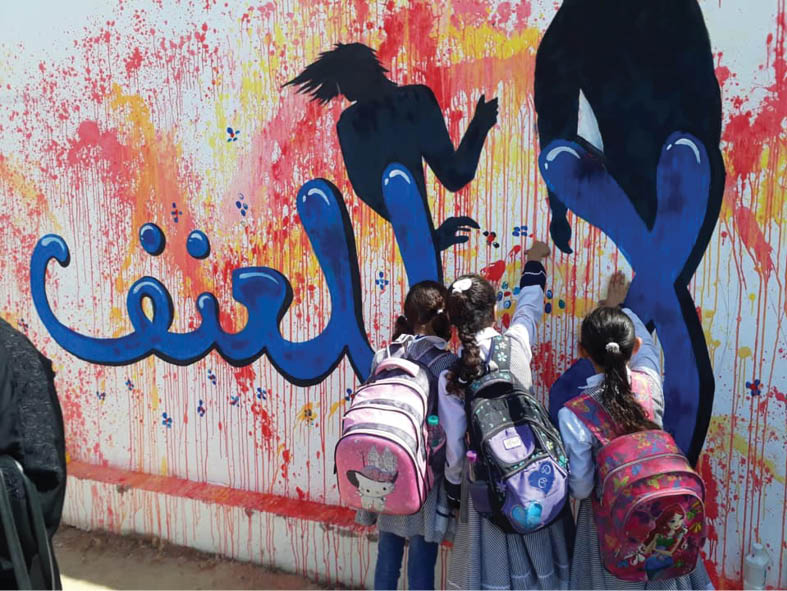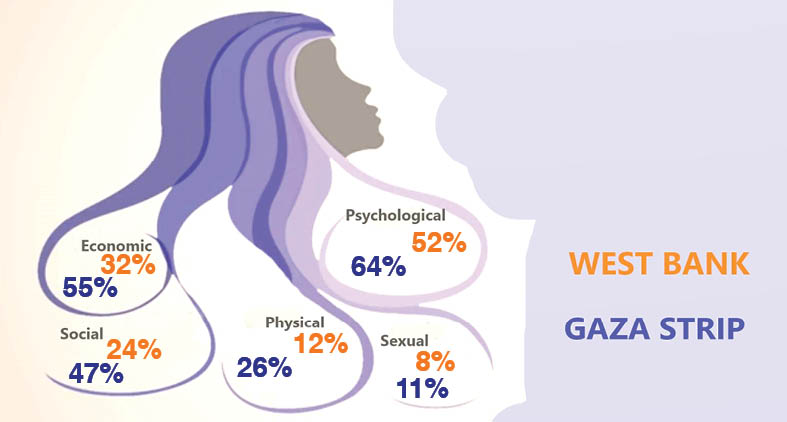Palestinian society suffers from two forms of violence. First, and most complicated to measure, is the violence associated with the Israeli occupation that not only affects the daily lives of people but also causes other forms of violence. Second is domestic violence; it affects the most vulnerable and marginalized groups and is carried out mainly against women, girls, children, persons with disabilities, and the elderly. The double impact of both forms of violence threatens the fabric of our community and makes measuring violence an extremely challenging task.
Results of the 2019 violence survey*1 showed that one out of three women in Palestine is subjected to violence by her husband; 57 percent of women suffered from psychological violence, the most common type of violence, followed directly by economic violence (41 percent). Among marginalized groups, results showed that 37 percent of women with disabilities suffered from domestic violence. Even though the general prevalence of violence has decreased in Palestinian society when compared to the results of the 2011 survey, the percentages remain of high concern.
Palestinian society suffers both from violence associated with the occupation and from domestic violence and violence in schools. The former may cause or intensify the latter, and their double impact affects the victims with particular intensity.
While many organizations have engaged in efforts to combat violence against women and other victims of violence, the results of the survey indicate clearly that these efforts have not been enough. We have not been able to break the silence regarding violence, as 61 percent of abused women did not report the abuse to anyone, and 24 percent of the victims left their homes to stay with their parents, siblings, or relatives. Equally alarming is that only 1 percent of abused women headed towards psychological and social centers to seek legal help, while yet another red flag is that 60 percent of abused women did not know of the existence or location of such centers that provide these services in the governorate, locality, or region where they live. The results reflect the fact that we all have failed to protect these women. They stress that we must collaborate, take on our complementary roles, and engage to make this issue a priority and implement the necessary interventions.

The high occurrence of violence in Palestinian society is a main obstacle towards the realization of human rights, women’s participation in the labor market, and economic and social development.
Dangerously, the loop of violence tends not to be limited to only one individual. Violence is a vicious cycle with long-term effects on the entire family and on the community as a whole. Children who grew up in households that were exposed to violence by a member/the husband are more likely to suffer from a number of behavioral and emotional disorders that at later stages in their lives can cause them to become perpetrators of violence themselves. When one partner is subjected to violence, similar behavior is usually practiced also against the children. Results showed that 44 percent of children between the ages of 12 to 17 years were exposed to at least one form of violence, carried out by the father or the mother. Also, 77 percent of children under the age of 12 years had been exposed to psychological violence by the caregiver (mother, father’s wife, or father), 65 percent of children had been exposed to physical violence, and 22 percent were exposed to severe physical violence. These numbers are alarming and concerning!

Results furthermore showed that violence is not limited to households, it is widely spread in our educational institutions as well. Twenty-five percent of children reported having been exposed to violence in schools; 17 percent of children were exposed to physical violence by a teacher, and 15 percent were exposed to psychological and verbal abuse.
Palestinian society is undergoing change, and we witnessed a noticeable positive development in various areas. This can be seen in education, as the illiteracy rate is only 3 percent, and more than 60 percent of the students enrolled in higher education institutions are women.
This number is related to early marriage, as among women currently aged 20–24 years, the percentage of those who married before the age of 18 years has decreased sharply and reached 11 percent in 2017, compared to 30 percent in 1997. But because this percentage was still high, the Palestinian government decided to set the minimum age for marriage at 18 years, a measure that is considered a big step and may enhance gender equality.
The improved percentages and implemented actions show that change is indeed possible. It is time to classify violence – especially when carried out against women, girls, children, persons with disabilities, and the elderly – as a serious issue. Strict measures must be taken to eliminate such violence, thereby enhancing gender equality and empowering vulnerable segments of our society.
*1 Preliminary Results of the Violence Survey in the Palestinian Community 2019, Palestinian Central Bureau of Statistics, available at http://pcbs.gov.ps/Downloads/book2480.pdf.


